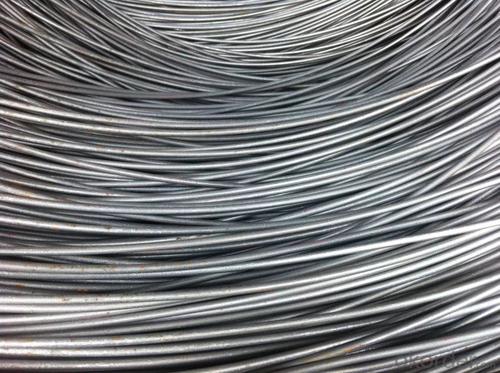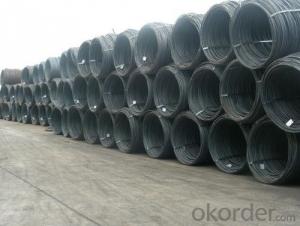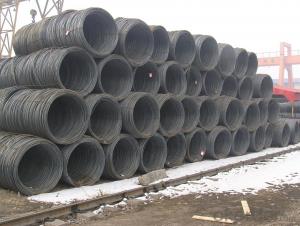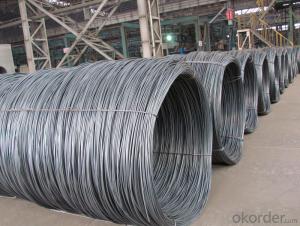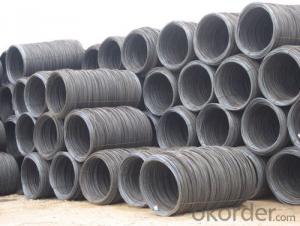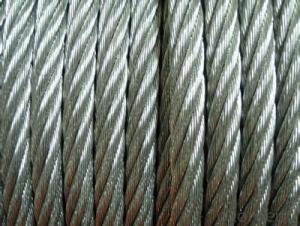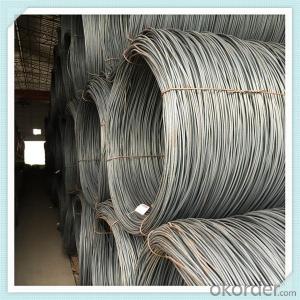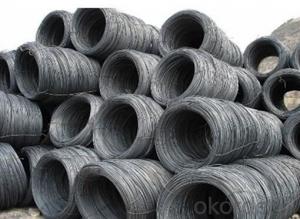Wire Rod Of Mild Steel_8mm
- Loading Port:
- China Main Port
- Payment Terms:
- TT OR LC
- Min Order Qty:
- -
- Supply Capability:
- -
OKorder Service Pledge
OKorder Financial Service
You Might Also Like
Specifications of Steel Wire Rod in Coil:
Steel Grade: Q195/235, SAE1006-1018B Standard: ASTM, GB
Diameter: 6.5mm
Type: Drawn Wire Alloy or Not: Alloy
Technique: Hot Rolled
Usage and Applications of Hot Rolled Wire Rod:
After hotrolled the products shaped into coil and delivery as finished product, including round, square, rectangular, hexagonal and so on. Since most of the products are round, it is generally called wire rod. Carbon steel wire rod is widely used in construction and manufacturing. Carbon steel wire rod is mainly used for reinforcement of reinforced concrete and welded structure or reprocessed (roberts , nail, etc.) materials, especially used to produce wire drawing, welding electrode, nails, spring, electronic, precise machinery parts and so on.
Packaging & Delivery of Hot Rolled Wire Rod:
Packaging Detail: products are packed in coil, each coil weight around 2 MT, and then shipped by container or bulk vessel
Delivery Detail: within 45 days after received deposit or LC.
Label: to be specified by customer, generally, each bundle has 1-2 labels
Trade terms: FOB, CFR, CIF
Note:
1. Our products are produced according to national standard (GB), if not, supply according to national standards (GB) or agreement as customer required.
2. Other Grade and Standard carbon steel wire rod we can supply:
Grade: H08A, 30MnSi, 62B-82B
Standard: AISI, BS, JIS, DIN
The Minimum Order Quantity of these products is high, and need to be confirmed.
3. We can not only supply carbon steel wire rod; if you need anything about building materials, please contact us.
4. Please send us your detail specifications when inquire. We will reply to you as soon as possible. We sincerely hope we can establish a long stable business relationship.
- Q: How does the diameter of steel wire rod affect its strength?
- The diameter of a steel wire rod directly affects its strength. Generally, a larger diameter wire rod will have higher strength compared to a smaller diameter wire rod. This is because a larger diameter rod has a greater cross-sectional area, allowing it to withstand higher loads and stresses without breaking or deforming.
- Q: How is steel wire rod used in the production of reinforcing bars?
- Steel wire rod is used in the production of reinforcing bars by being stretched and twisted into a spiral shape, known as ribbing. This ribbing provides enhanced strength and grip, allowing the reinforcing bars to effectively reinforce and strengthen concrete structures.
- Q: What are the different types of wire drawing dies used for steel wire rod?
- There are several types of wire drawing dies that are commonly used for steel wire rod. These include: 1. Single crystal natural diamond dies: These dies are made from a single crystal diamond and are known for their high hardness and wear resistance. They can be used for drawing high carbon steel wire rod as well as stainless steel wire rod. 2. Polycrystalline diamond (PCD) dies: PCD dies are made from multiple small diamond crystals that are bonded together. They offer good wear resistance and can be used for drawing steel wire rod with intermediate carbon content. 3. Tungsten carbide dies: Tungsten carbide is a hard and durable material that is often used for wire drawing dies. These dies can handle high carbon steel wire rod and are known for their ability to withstand high pressures and temperatures. 4. Natural diamond dies with carbide support: These dies have a natural diamond core with a carbide support structure. The diamond provides excellent wear resistance while the carbide support adds strength and stability. They are suitable for drawing steel wire rod with high carbon content. 5. PCD dies with carbide support: Similar to the above, these dies have a PCD core with a carbide support structure. They offer good wear resistance and can handle steel wire rod with intermediate carbon content. 6. Polycrystalline diamond composite (PDC) dies: PDC dies are made by sintering diamond particles with a binder material. They are known for their high wear resistance and are often used for drawing steel wire rod with low to medium carbon content. Each type of wire drawing die has its own advantages and is suitable for specific applications based on the carbon content and other properties of the steel wire rod being drawn.
- Q: How is steel wire rod used in the production of cables?
- Steel wire rod is used in the production of cables as it serves as the core material to provide strength and conductivity. It is typically used as the central support structure around which the cable is built. The steel wire rod is drawn and coated with various materials, such as copper or aluminum, to enhance its electrical properties and protect it from corrosion. This process allows for the creation of durable and reliable cables that are capable of transmitting electricity or telecommunications signals effectively.
- Q: How is steel wire rod used in the production of wire strands for suspension bridges?
- Wire strands for suspension bridges rely heavily on steel wire rod as a fundamental component. The wire rod acts as the primary material from which the wire strands are fabricated. To create wire strands for suspension bridges, a series of procedures are applied to the steel wire rod. Firstly, the wire rod undergoes a thorough cleansing and inspection to verify its compliance with the specified requirements. Subsequently, the wire rod is passed through a sequence of rollers in order to decrease its diameter and increase its length. This procedure, known as cold drawing, enhances the wire's strength and flexibility. Once the wire rod has been drawn, it usually receives a protective coating to prevent corrosion. The type of coating applied may vary depending on the specific demands of the bridge and the environmental conditions in which it will be installed. Common coating options include zinc, epoxy, and galvanized coatings. After the wire rod has been coated, it is then transformed into wire strands. This is achieved by intertwining multiple wires together to form a single strand. The number of wires twisted together can vary based on the design and load requirements of the suspension bridge. The twisting process is meticulously controlled to ensure that the wire strands possess the necessary strength and durability to withstand the tension and stress they will encounter during use. Once the wire strands have been created, they are typically subjected to testing to confirm that they meet the required strength and quality standards. This may involve conducting various tests such as tensile strength tests, corrosion resistance tests, and fatigue tests. Only wire strands that successfully pass these tests are deemed suitable for use in suspension bridges. Finally, the wire strands are assembled and installed in the structure of the suspension bridge, providing vital support and load-bearing capacity. These wire strands are typically anchored at both ends of the bridge and connected to the bridge deck and towers, resulting in a sturdy and durable structure capable of carrying heavy loads over long distances. In conclusion, steel wire rod plays a critical role in the production of wire strands for suspension bridges. Through processing, coating, and formation, wire strands with the necessary strength and flexibility are created to support the bridge structure. The meticulous manufacturing and testing processes ensure that the wire strands meet the necessary safety and reliability standards for use in suspension bridges.
- Q: How is steel wire rod used in the manufacturing of wire for suspension bridges?
- The manufacture of wire for suspension bridges relies heavily on steel wire rod, a vital component. Initially, a steel mill uses a technique called hot rolling to produce the wire rod. This involves heating the steel and passing it through a series of rollers to shape it into a long, continuous rod. The rod is then cooled and cut into shorter lengths, which are further processed to create wire for suspension bridges. During the manufacturing process, the steel wire rod undergoes several steps. Firstly, it is cleaned and coated with a protective layer to prevent corrosion. Next, it is drawn through a set of dies, gradually reducing the wire's diameter while increasing its length. This drawing process strengthens the wire and enhances its tensile strength, making it suitable for suspension bridges. Once the wire has been drawn to the desired size, additional processing is carried out to meet the specific requirements of suspension bridge construction. This may involve heat treatment to improve mechanical properties, such as fatigue resistance and flexibility. After processing, the wire is spooled onto large reels and transported to the construction site. There, it is unwound from the reels and used to form the main cables of the suspension bridge. These cables consist of multiple strands of steel wire twisted together to provide the necessary strength and stability. The selection of steel wire rod for suspension bridge manufacturing is based on its high strength, durability, and resistance to environmental factors like corrosion. It undergoes rigorous testing and quality control measures to ensure it meets the required specifications and standards. In summary, steel wire rod is a crucial element in the construction of suspension bridges. It provides the strength and stability needed to support the bridge's weight and withstand external forces. The use of steel wire rod in suspension bridge construction is essential for ensuring the safety and longevity of these structures.
- Q: What are the future prospects for the steel wire rod industry?
- The future prospects for the steel wire rod industry appear promising. With increasing global infrastructure development and industrialization, the demand for steel wire rods is expected to grow. Additionally, the rising popularity of electric vehicles and renewable energy projects will require substantial amounts of steel wire rods for their manufacturing and installation. However, the industry may face challenges related to environmental concerns and competition from alternative materials. Overall, with proper adaptation and innovation, the steel wire rod industry is likely to thrive in the coming years.
- Q: What is the difference between a wire rod and a straight bar?
- Wire rods and bars are generally used in reinforcing bars
- Q: What are the different international standards for steel wire rod?
- There are several international standards for steel wire rod that have been established by various organizations and regulatory bodies. These standards ensure that steel wire rod meets the necessary quality and performance requirements for different applications. Some of the most widely recognized international standards for steel wire rod include: 1. ISO 16120-1:2011 - This standard specifies the general requirements for steel wire rod, including dimensions, tolerances, and mechanical properties. It covers both carbon and alloy steel wire rod. 2. ASTM A510/A510M - This standard is published by the American Society for Testing and Materials (ASTM) and provides the requirements for carbon and alloy steel wire rod. It covers various grades and specifies the chemical composition, mechanical properties, and dimensional tolerances. 3. JIS G 3503 - This Japanese industrial standard defines the requirements for low carbon steel wire rods for general use. It specifies the chemical composition, mechanical properties, and dimensional tolerances. 4. BS EN 10016-2:2017 - This European standard specifies the technical delivery conditions for non-alloy steel wire rod for cold heading and cold extrusion. It covers the chemical composition, mechanical properties, and dimensional tolerances. 5. DIN 17140:1976 - This German standard provides the technical delivery conditions for unalloyed steel wire rod for general purposes. It specifies the chemical composition, mechanical properties, and dimensional tolerances. These international standards serve as guidelines for manufacturers, suppliers, and customers in the steel wire rod industry. They ensure that the product meets the necessary quality standards and can be used reliably in various applications such as automotive, construction, and manufacturing.
- Q: How is steel wire rod used in the agriculture industry?
- Steel wire rod is commonly used in the agriculture industry for various purposes. It is primarily used for constructing fences and enclosures to protect crops and livestock from external threats. Additionally, steel wire rod is used for supporting and training plants, as well as creating trellises for vine plants. Its strength and durability make it an ideal material for these applications, ensuring the safety and productivity of agricultural operations.
Send your message to us
Wire Rod Of Mild Steel_8mm
- Loading Port:
- China Main Port
- Payment Terms:
- TT OR LC
- Min Order Qty:
- -
- Supply Capability:
- -
OKorder Service Pledge
OKorder Financial Service
Similar products
Hot products
Hot Searches
Related keywords

